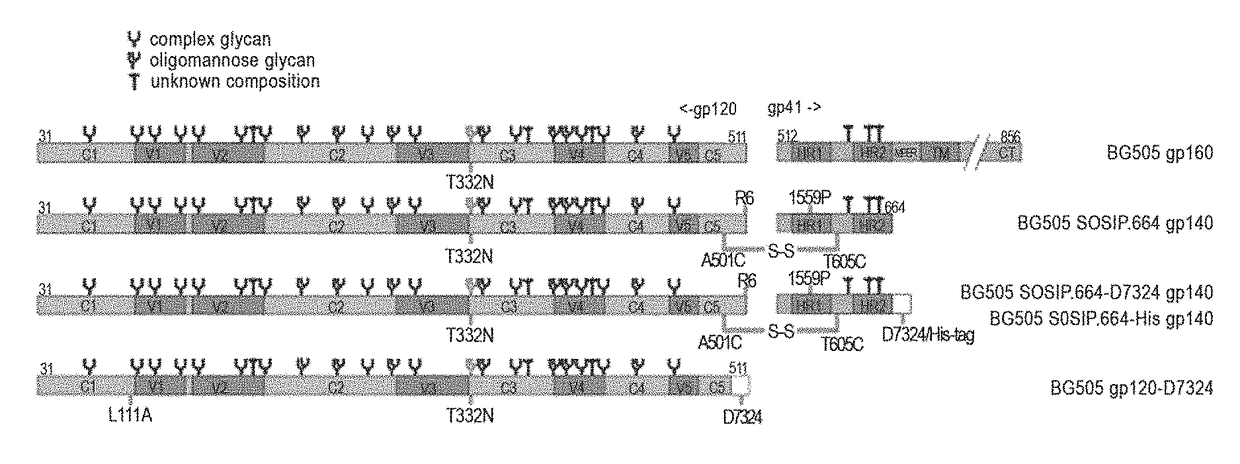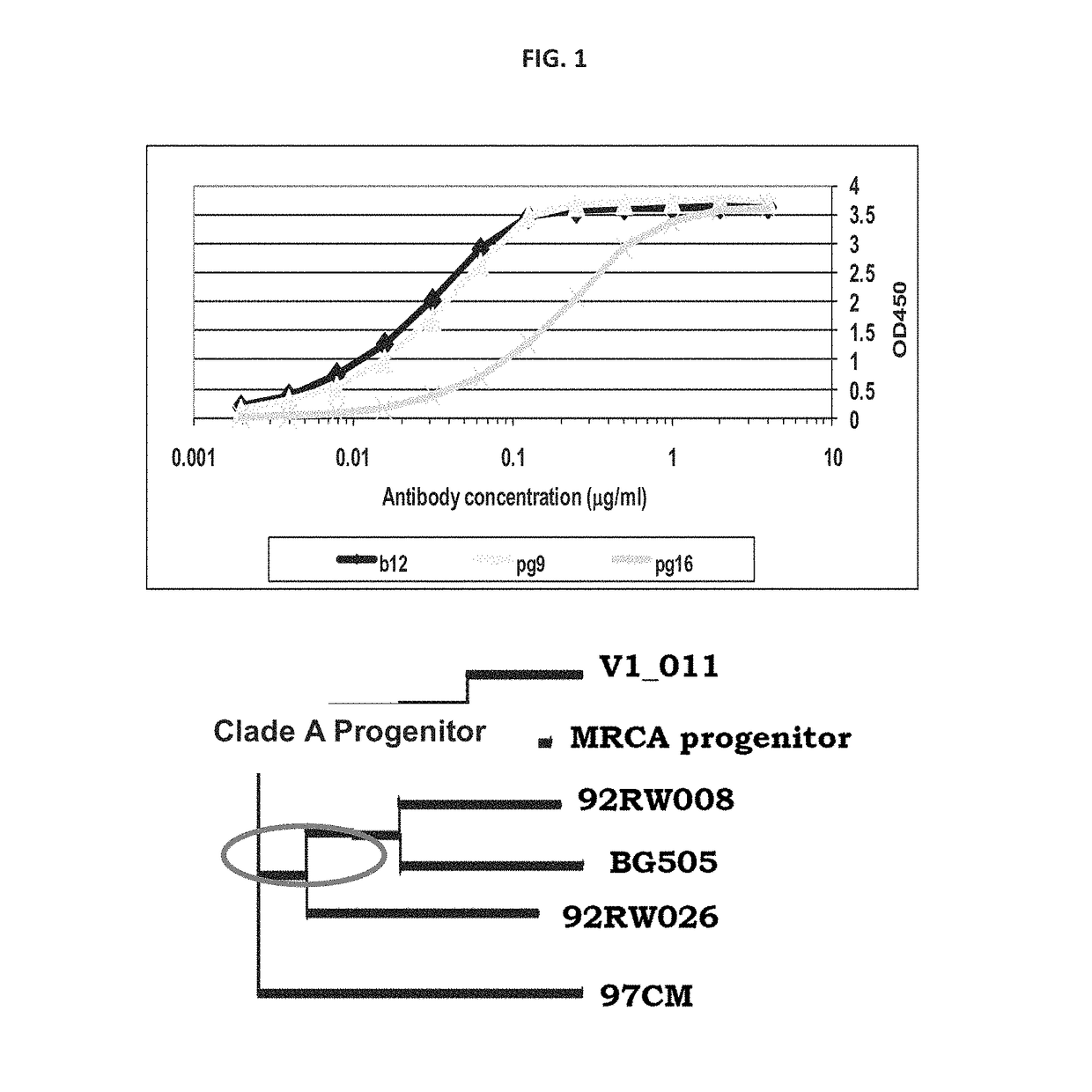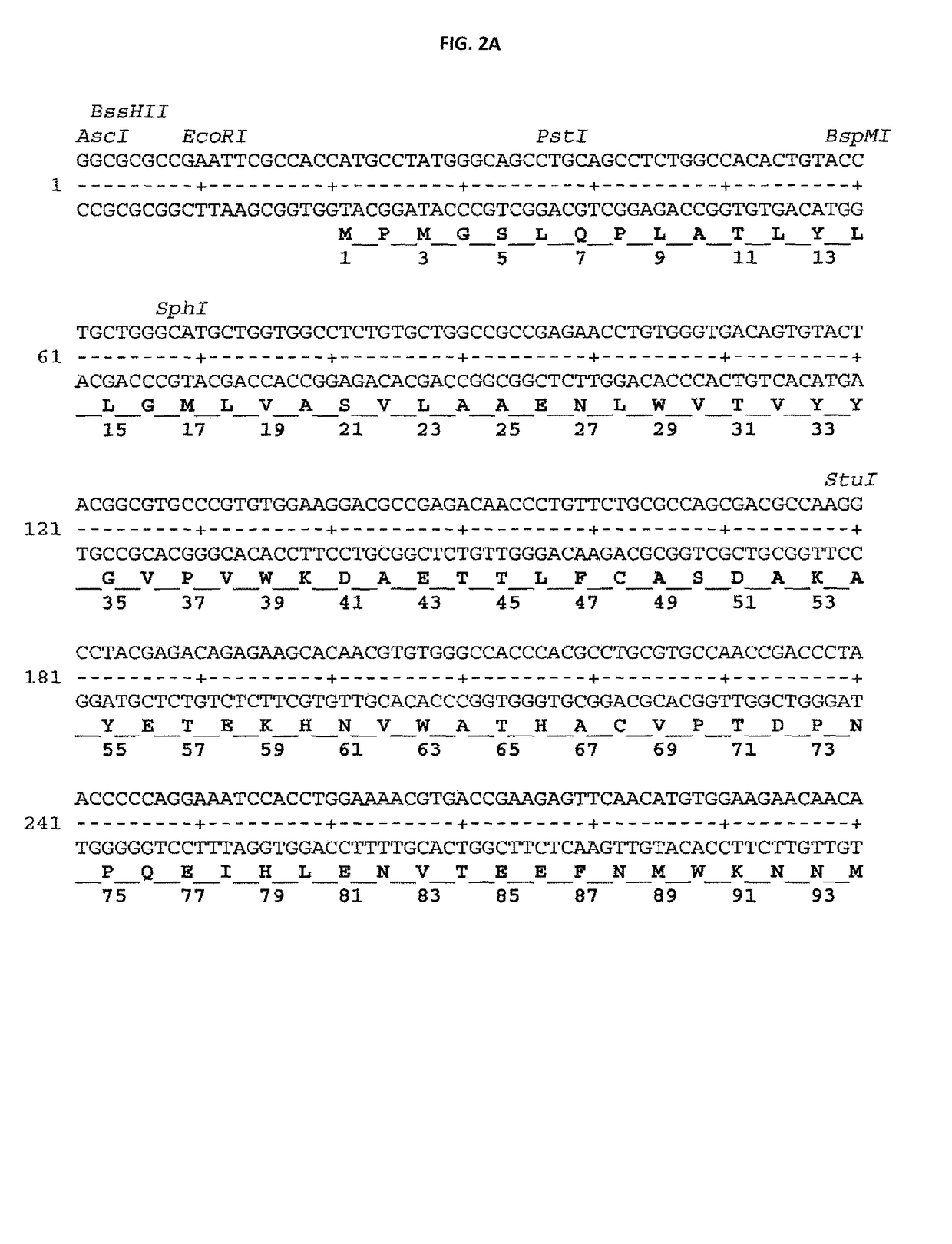HIV-1 envelope glycoprotein
a glycoprotein and envelope technology, applied in the field of new envelope glycoproteins, can solve the problems of affecting the ability to elicit broad and potent neutralizing antibodies, and affecting the body's ability to fight most invaders
- Summary
- Abstract
- Description
- Claims
- Application Information
AI Technical Summary
Benefits of technology
Problems solved by technology
Method used
Image
Examples
example 1
Supersite of Immune Vulnerability on the Glycosylated Face of HIV-1 Envelope Glycoprotein gp120
[0126]PG9 is the founding member of a growing family of glycan-dependent human antibodies that preferentially bind the HIV-1 Env trimer and broadly neutralize HIV-1. Here, a soluble SOSIP.664 trimer was constructed from the Clade A BG505 sequence that binds PG9 with high affinity (˜30 nM), enabling combined structural and biophysical characterization of the PG9: Env trimer complex. The BG505 SOSIP.664 trimer is remarkably stable as assessed by electron microscopy (EM) and differential scanning calorimetry. EM, SAXS, SEC-MALS and ITC indicate that one PG9 Fab binds per Env trimer near the spike apex. An ˜18 Å EM reconstruction demonstrates that PG9 recognizes the Env trimer asymmetrically via contact with two of the three gp120 protomers. Molecular modeling and ITC binding experiments with an engineered PG9 mutant suggest that, in addition to the N156 and N160 glycan interactions observed i...
example 2
Supersite of Immune Vulnerability on the Glycosylated Face of HIV-1 Envelope Glycoprotein gp120
[0156]Sera from a proportion of HIV-infected donors exhibit potent neutralizing antibody activity against globally diverse viruses, suggesting an AIDS vaccine is feasible. A substantial fraction of antibodies in such sera recognize an epitope dependent on a glycan at Asparagine 332 (N332) on the HIV-1 gp120 surface glycoprotein. Here, Applicants elucidate how broadly neutralizing antibody (bnAb) PGT 135 recognizes its N332-dependent epitope from its crystal structure with gp1120, CD4 and Fab 17b at 3.1 Å resolution. PGT135 interacts with three glycans at N332, N392 and N386, and uses two long CDR loops (H1, H3) to reach through the glycan shield so as to access the gp120 protein surface around V4. This mode of recognition contrasts with other bNabs PGT 128 and 2G12, which also recognize N332-dependent epitopes but engage different constellations of the surrounding sugars. Electron microsco...
example 3
Cleaved, Soluble HIV-1 Env Trimers Presenting Multiple bNAb Epitopes
[0228]Soluble Env trimers that mimic the native viral spike may induce broadly neutralizing antibodies (bNabs). One guide to spike-mimetic strategies is how well multiple bNAb epitopes are presented and, conversely, irrelevant epitopes occluded. A true spike-mimetic should also be cleaved between gp120 and gp41, as this event modifies trimer antigenicity.
[0229]Applicants deleted the MPER from cleaved, stabilized SOSIP gp140 trimers, to reduce aggregation and facilitate structural studies. Screening multiple Env proteins for stability, expression levels and bNAb reactivity focused attention on the BG505 (clade A) sequence. Mutagenesis restored additional bNAb epitopes. The BG505 SOSIP.664 gp140 was expressed and the trimer fraction purified. Antigenicity was determined using SPR, ELISA (His-tagged variants), and ITC and EM studies, as well as neutralization assays were performed.
[0230]The BG505 SOSIP.664 trimers were...
PUM
| Property | Measurement | Unit |
|---|---|---|
| temperature | aaaaa | aaaaa |
| concentration | aaaaa | aaaaa |
| concentration | aaaaa | aaaaa |
Abstract
Description
Claims
Application Information
 Login to View More
Login to View More - R&D
- Intellectual Property
- Life Sciences
- Materials
- Tech Scout
- Unparalleled Data Quality
- Higher Quality Content
- 60% Fewer Hallucinations
Browse by: Latest US Patents, China's latest patents, Technical Efficacy Thesaurus, Application Domain, Technology Topic, Popular Technical Reports.
© 2025 PatSnap. All rights reserved.Legal|Privacy policy|Modern Slavery Act Transparency Statement|Sitemap|About US| Contact US: help@patsnap.com



